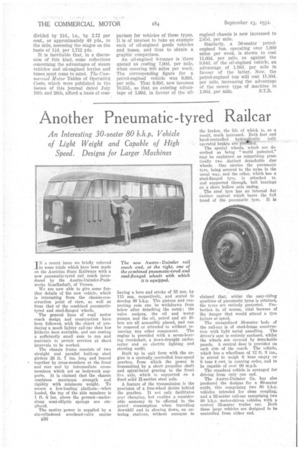Another Pneumatic-tyred Railcar
Page 54

If you've noticed an error in this article please click here to report it so we can fix it.
An Interesting 30-seater 80 b.h.p. Vehicle of Light Weight and capable of High Speed. Designs for Larger Machines
I N a recent issue we briefly referred to some trials which have been made on the Austrian State Railways with a new pneumatic-tyred rail coach introduced by the Austro-Daimler-Puckwerke Geselkehaft, of Vienna.
We are now able to give some further details of the new vehicle, which is interesting from the chassis-construction point of view, as well as from that of the combined pneumatictyred and steel-flanged wheels.
The general lines of road motor coach design and construction have been followed, with the object of producing a much lighter rail-car than has hitherto been available, and one costing a sufficiently small sum to run and maintain to permit services at short intervals to be worked.
The chassis frame consists of two straight and parallel built-up steel girders 26 ft. 7 ins, long and braced
• together by cross-members at the front and rear and by intermediate crossmembers which act as bodywork supports. It is claimed that the chassis combines maximum strength and rigidity with minimum weight. To secure a low-loading platform—when loaded, the top of the side members is 1 ft. 6 ins, above the ground—underslung semi-elliptic springs are employed.
The motive power is supplied by a six-cyllndered overhead-valve engine 3336
haying a bore and stroke of 85 nun. by 115 mm. respectively, and stated to develop 80 b.h.p. The pistons and connecting rods can be withdrawn from below after detaching the sump; the valve rockers, the oil and water pumps, and the oil, petrol and air filters are all accessibly placed, and can be removed or attended to without re
moving any other component. The engine is provided with a seven-bearing crankshaft, a down-draught carburetter and an electric lighting and starting outfit.
Built up in unit form with the engine is a centrally controlled four-speed gearbox, from w-hieh the power is transmitted by a short propeller shaft and spiral-bevel gearing to the front live axle, which is supported on a fixed solid H-section steel axle.
A feature of the transmission is the provision of a free-wheel device behind the gearbox. It not only facilitates gear changing, but enables a considerable economy to be effected in the petrol consumption when travelling downhill and in slowing down, on entering stations, without recourse to
the brakes, the life of which is, as a result, much increased. Both foot and hand-controlled hydraiiikally (oil). operated brakes are Pi6Med.
The special wheels, which are described as being " world patented," may be explained as comprising prac.tically two distinct detachable disc wheels. One carries the pneumatic tyre, being secured to the axles in the usual way, and the other, which has a steel-flanged tyre, is attached to. and supported through, ball bearings on a short hollow axle casing.
The steel tyre has an internal flat surface against which bears the full tread of the pneumatic tyre. It is claimed that, whilst the easy-riding qualities of pneumatic tyres is retained, the tyres are entirely protected. Protection is, of course, vital because of the danger that would attend a Ore failure at speed.
The streamlined 30-seater body of the rail-car is of steel-frame construction with light metal panelling. The driver's seat is entirely enclosed, whilst the wheels are covered by detachable panels. A central door is provided on each side of the coach. The vehicle, which has a wheelbase of 12 ft. 9 ins., is stated to weigh 6 tons empty or 6 tons 4 cwt. in running order, and to be capable of over 60 m.p.h.
The standard vehicle is arranged for driving from only one end.
The Austro-Daimler Co. has also produced the designs for a 60-seater outfit, this comprising two 80 b.h.p. vehicles intended for close coupling, and a 92-seater rail-car comprising two 80 b.h.p. motor-driven vehicles with a central 32-seater trailer ear. Both these large vehicles are designed to he controlled from either end.






































































































